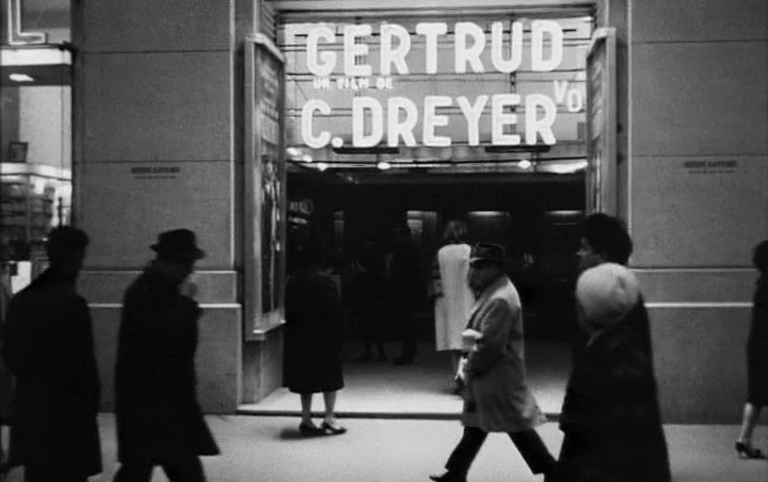
Hopeless romantic Gertrud (Nina Pens Rode) inhabits a turn-of-the-century milieu of artists and musicians, where she pursues an idealized notion of love that will always elude her. She abandons her distinguished husband (Bendt Rothe) and embraces an affair with a young concert pianist (Baard Owe), who falls short of her desire for lasting affection. When an old lover (Ebbe Rode) returns to her life, fresh disappointments follow, and Gertrud must try to come to terms with reality.
EN
Erland: Who are you, really?
Gertrud: I am many things.
“Let’s take the risk of plunging into film without asking permission. Let’s invent our own standards and trust only in spontaneous criticism, which does exist. There are quite a few of us who believe in nothing else. Quite a few of us see the names Carl Theodor Dreyer or Jean-Marie Straub on a poster or a flyer and go to see their films. They are filmmakers whose films the professional critics forbid us to see. That alone is reason enough to go and see them.
In 1964 one of the great film masterpieces, Dreyer’s Gertrud, was killed and buried by the critics (it played in Paris for one week). Who was responsible? You, who believed the critics. Too late.”
Marguerite Duras1
“At once the telling of a dream and a session of analysis (an analysis in which the roles are unceasingly changing; subjected to the flow, the regular tide of the long takes, the mesmeric passes of the incessant camera movements, the even monotone of the voices, the steadiness of the eyes – always turned aside, often parallel, towards us: a little above us – the strained immobility of the bodies, huddled in armchairs, on sofas behind which the other silently stands, fixed in ritual attitudes which make them no more than corridors for speech to pass through, gliding through a semi-obscurity arbitrarily punctuated with luminous zones into which the somnambulists emerge of their own accord...).”
Jacques Rivette2
“Seeing again Gertrud today, or quite simply seeing it as if no one had ever seen it before, amounts to a shock. Dreyer is one of the giants of cinema. In 1964, this theatre play filmed in black and white, with its antiquated theme (Love with a capital L), its unknown, straight-laced Danish actors, looked like some quaintly old-fashioned and half-witted classic lost among the spruce new-wavery of modern cinema. Only his admirers perceived once more Dreyer’s terrifying modernity, the logical progression of forty years of cinema spent probing the bottomlessness of love, and the false bottoms of the scenographic cube, employing white as torture, and music (or else tears) as what arises when words are no longer enough. And today, at a point when this modernity is apparent to everyone, the film is still ahead of its time. (...) The most beautiful grey-scale photography in the history of cinema lays out endless layers of light like clouds of time, and since everything is irremediable, nothing looms through them.”
Serge Daney3
“Gertrud is the invention of a man, the invention of two men: the film was made after a play by Hjalmar Söderberg. Gertrud is a statue, a monument, like many women in Dreyer’s films. Her demands are as absolute as the contours of the film, its spaces and the gestures of its characters are hard and angular. Her demands are too idealistic, which is how you recognise the detour via the men. But occasionally you hear the long dresses rustle, a certain intimacy setting in. And then she goes to Paris to study with Charcot, Freud’s teacher. This real name in a fictional context forces a breakthrough comparable to that of the nature image in Michael. The long-valid order now cracks. With reality, another dimension emerges.”
Friede Grafe4
“In Gertrud (1964), his very last film, Dreyer uses frame compositions to situate characters near sculptures that express or inform on their state of mind – in the scenes in the park, for instance, Gertrud and her young lover are in the vicinity of a copy of the Medici Venus. In addition, the stasis and long-take aesthetics of Dreyer’s later works are worked into a series of tableaux vivants that give the characters a statuary presence. His films play on a certain monumentality of the human figure, that is fixed. In so doing, the characters in Gertrud can be compared with the sculptures that Dreyer filmed for Thorvaldsen (1949).”
Steven Jacobs5

- 1Marguerite Duras, « Othon: Jean-Marie Straub, » In: Outside: Selected Writings (Boston: Beacon, 1997), 155-157. Originally published in Politique-Hébdo on January 14, 1971. Translation: Art Goldhammer.
- 2Jean Narboni, Sylvie Pierre and Jacques Rivette, “Montage,” In: Jacques Rivette: Texts and Interviews (London: BFI, 1977). Originally published in Cahiers du cinéma, nr. 210, March 1969. Translated by Tom Milne.
- 3Serge Daney, “Gertrud,” Serge Daney in English, November 14, 2020. Originally published in Libération on October 12, 1983.
- 4Frieda Grafe, “Carl Theodor Dreyer. Spiritual Gentlemen and Natural Ladies,” Sabzian, May 24, 2023. Translated by Sis Matthé. Originally published as “Carl Theodor Dreyer. Geistliche Herren und natürliche Damen” in Süddeutsche Zeitung, February 9-10, 1974.
- 5Steven Jacobs, “Carving Cameras on Thorvaldsen and Rodin: Mid-Twentieth Century Documentaries on Sculpture,” In: Steven Jacobs, Susan Felleman, Vito Adriaensens and Lisa Colpaert (eds.), Screening Statues: Sculpture in Film (Edinburgh: Edinburgh University Press, 2017), 65-83.

